Table of Contents
Finding the right source for gardening advice can shape every project from a windowsill plant to a backyard overhaul. Some platforms inspire with beautiful ideas while others give you step by step help or expert comparisons you can trust. Whether you are new to plant care or looking to fine tune your growing space, the right guidance saves time and keeps plants thriving. With so much advice out there, sorting through it all can be tricky. Exploring how each gardening site serves up tips or tools might reveal the perfect fit for your needs.
Table of Contents
- Lushy Gardens
- The Spruce
- Gardenista
- Epic Gardening
- Gardeners’ Path
- Smart Garden Guide
- Gardening Know How
Lushy Gardens
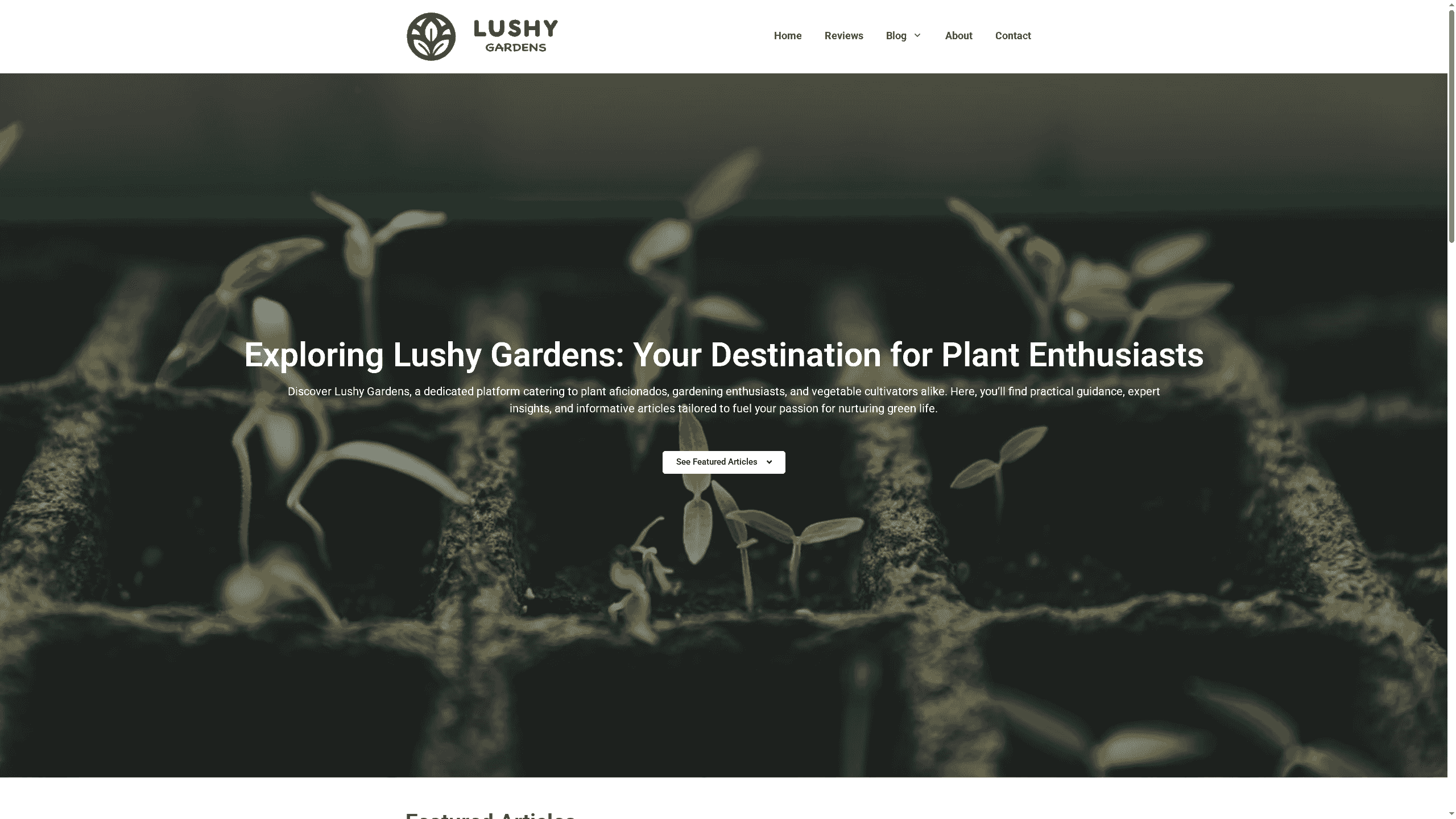
At a Glance
Lushy Gardens is a focused, free-to-access platform for plant enthusiasts and vegetable growers that delivers practical guidance, expert comparisons, and hands-on plant care advice. The site blends deep-dive articles on indoor plant pots, air-purifying plants, and vertical gardening with clear tips for both beginners and experienced gardeners. Bottom line: if you want reliable, usable information to help indoor plants thrive, Lushy Gardens is a top pick.
Core Features
Lushy Gardens centers on curated, practical content: expert comparison guides on gardening tools and indoor plant pots, articles about air quality improvements with indoor plants, and step-by-step tips for vertical indoor gardens and general plant care. The site also covers plant hardiness zones and climate considerations to help you match plants to your environment. These features are presented in user-friendly articles designed to be actionable rather than theoretical. Limitations are intentional design choices: the focus is on published guidance rather than on garden design portfolios, direct e-commerce, or live interactive features.
Pros
- Comprehensive and detailed gardening guides: The site offers thorough articles that walk you through techniques and product comparisons in depth.
- Expert insights and comparisons on gardening products: Lushy Gardens prioritizes side-by-side analysis so you can weigh tool and pot options with confidence.
- Variety of topics covering different aspects of gardening and plant care: From air-purifying plants to vertical gardens, the content spans the common needs of indoor gardeners.
- User-friendly articles aimed at all experience levels: Content is written so beginners can follow while still offering value to more experienced growers.
- Engages community with content from an experienced gardener, Eleanor: The personal touch from Eleanor builds trust and offers relatable, tested advice.
Who It’s For
Lushy Gardens is ideal for plant enthusiasts, gardening hobbyists, indoor gardeners, vegetable growers, and anyone keen to learn concrete plant care techniques. Whether you’re a beginner seeking basic care tips or an experienced gardener comparing tools and pots, the platform’s content and use cases—like indoor plant recommendations and vertical gardening guidance—map directly to your needs.
Unique Value Proposition
What sets Lushy Gardens apart is the combination of expert-led comparison content and practical, free guidance tailored to indoor and urban gardeners. Instead of trying to be everything—an e-commerce shop, a design studio, or a realtime forum—Lushy Gardens doubles down on high-quality, curated articles and comparisons that help you make informed choices quickly. The presence of an experienced gardener, Eleanor, gives the site a trustworthy voice that many competitors lack. This concentrated approach means you won’t wade through fluff: you get actionable recommendations on tools, pots, air-quality plants, and vertical garden setups, all at no cost. In short: deep, usable content delivered clearly and freely—designed for results.
Real World Use Case
A homeowner concerned about indoor air quality consults Lushy Gardens to identify top air-purifying plants, learn proper care routines, and compare the best pots for apartment environments—then applies those recommendations to improve indoor greenery and health.
Pricing
Free access to articles and guides (Free).
Website: https://lushygardens.com
The Spruce
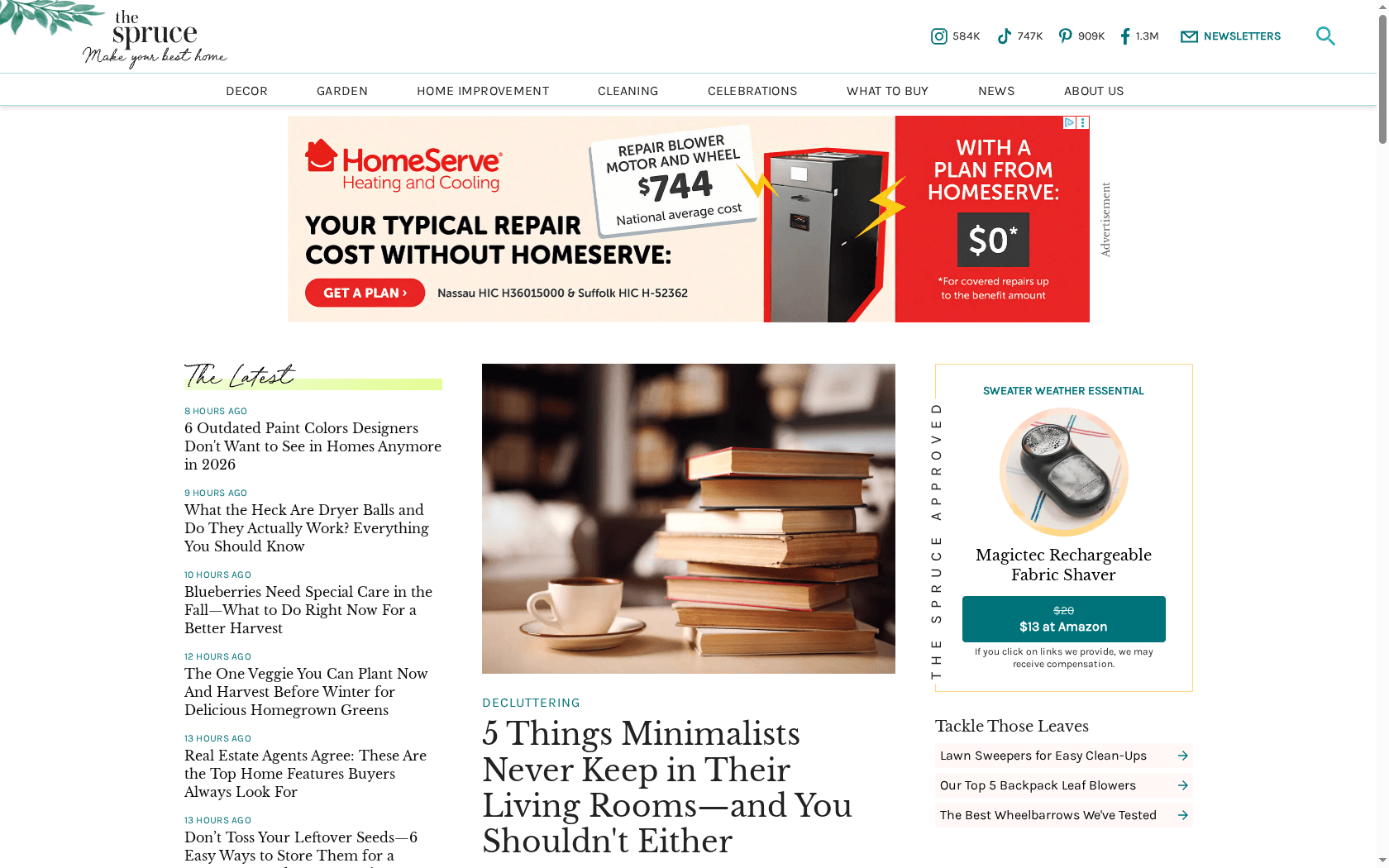
At a Glance
The Spruce is a comprehensive, editorial-driven resource for anyone tackling home improvement or gardening projects. Its strength lies in rigorously tested product reviews and clear, expert-led guides that cover decorating, cleaning, DIY, and garden care. If you want well-researched how-tos and reliable recommendations without paying a subscription, The Spruce delivers. It’s less useful if you expect direct e-commerce or quick one-click shopping experiences.
Core Features
The Spruce combines practical home improvement advice with lab-style product testing and expert commentary from editors and specialists. The site publishes in-depth guides across gardening, decorating, cleaning, and DIY projects and keeps content fresh with seasonal updates and trend coverage. In short: editorial guidance, tested product recommendations, and comprehensive category-first tutorials form its core capabilities.
Pros
- Trusted product reviews based on rigorous testing: Reviews are presented as outcomes of structured testing, which helps you compare options with confidence.
- Wide range of home-related topics: From garden care to interior updates, the site covers many cornerstones of home life in one place.
- Expert advice from dedicated editors: Specialist editors and contributors provide context and recommendations grounded in experience.
- Up-to-date trends and seasonal insights: Regular updates mean content reflects current styles and timely maintenance reminders.
- Comprehensive and detailed guides to assist various projects: Step-by-step pieces help you move from idea to finished project without guessing.
Cons
- Limited direct product sales or e-commerce options: The site focuses on editorial content and does not offer a robust shopping experience for immediate purchases.
- Content is primarily informational rather than transactional: If you want a marketplace or price comparison engine, The Spruce won’t serve that need directly.
- The website can be overwhelming for users seeking quick answers: The depth and volume of content sometimes make it harder to find a concise, single-solution answer quickly.
Who It’s For
Homeowners, renters, and gardening enthusiasts who value trustworthy guidance and step-by-step support will get the most from The Spruce. It’s ideal for DIYers planning renovations, gardeners seeking seasonal care instructions, and anyone researching product choices before buying. If you prefer curated editorial insight over a fast online storefront, this site is built for you.
Unique Value Proposition
The Spruce’s standout value is its blend of tested product recommendations and specialist-led editorial that helps readers make informed decisions. Rather than simply listing products, it explains why an option works, how to use it, and how it fits into a broader project plan.
Real World Use Case
A homeowner planning a kitchen renovation can consult The Spruce for design inspiration, vetted product options, and a step-by-step renovation guide—moving from concept sketches to a prioritized shopping list grounded in tested recommendations.
Pricing
Free access to all articles and guides.
Website: https://thespruce.com
Gardenista

At a Glance
Gardenista is a beautifully curated sourcebook for cultivated living that blends practical gardening advice with high-design inspiration. It serves up expert articles, garden visits, and curated product lists alongside subscriber-only newsletters and archived posts. If you value visually rich features and seasonal design trends, Gardenista is an excellent reference—but casual readers should expect some content behind a paywall.
Core Features
Gardenista centers on long-form content and practical resources: articles on gardening and landscape design, expert advice for outdoor living, in-depth garden visits and landscape architecture showcases, announcements for book releases and design dispatches, plus subscriber-only newsletters and archived posts that offer an ad-free reading experience. The site combines editorial features with curated product recommendations to help readers translate inspiration into real projects.
Pros
- Extensive design-focused content: Gardenista offers a deep well of garden and landscape design articles that inspire both aesthetic and practical decisions.
- Subscriber community and archive access: Members gain access to archived posts and community features that make it easier to revisit useful guides and connect with fellow enthusiasts.
- Curated product recommendations: The site’s curated products and expert advice simplify shopping and sourcing for garden projects.
- Regular seasonal updates: Frequent feature articles and seasonal pieces keep content timely and aligned with gardening cycles.
- Ad-free subscription option: Paying subscribers can enjoy an ad-free experience, which makes reading long articles more pleasant.
Cons
- Limited free archive access: Much of the archive and subscriber-only material requires a paid subscription, which restricts long-term reference for free users.
- Narrower focus on outdoor design: The site emphasizes gardening and landscape design more than indoor plant care or broader home topics, which may disappoint indoor-only plant owners.
- Subscription cost barrier: While priced reasonably for committed readers, the subscription cost may be a deterrent for casual visitors seeking occasional inspiration.
Who It’s For
Gardenista is ideal for garden enthusiasts, landscape designers, homeowners planning outdoor projects, and anyone who values design-forward gardening content. If you want visual inspiration paired with practical how-tos and curated shopping suggestions, this site fits the bill. If you’re primarily an indoor plant parent, you may find the focus less relevant.
Unique Value Proposition
Gardenista stands out by marrying high-quality editorial storytelling with practical garden resources: the site gives design-minded gardeners both aspirational garden visits and actionable advice, plus curated product lists that bridge the gap between ideas and execution.
Real World Use Case
A homeowner planning a garden overhaul can browse Gardenista for layout and planting ideas, read expert tips to avoid common mistakes, and use curated product links to source materials—then subscribe for archived case studies and newsletters that track seasonal progress.
Pricing
Starting at $5/month (annual plan at $59.99/year). Monthly subscriptions are $9.99, with discounts for annual payments and combined access to related sites included in some plans.
Website: https://gardenista.com
Epic Gardening
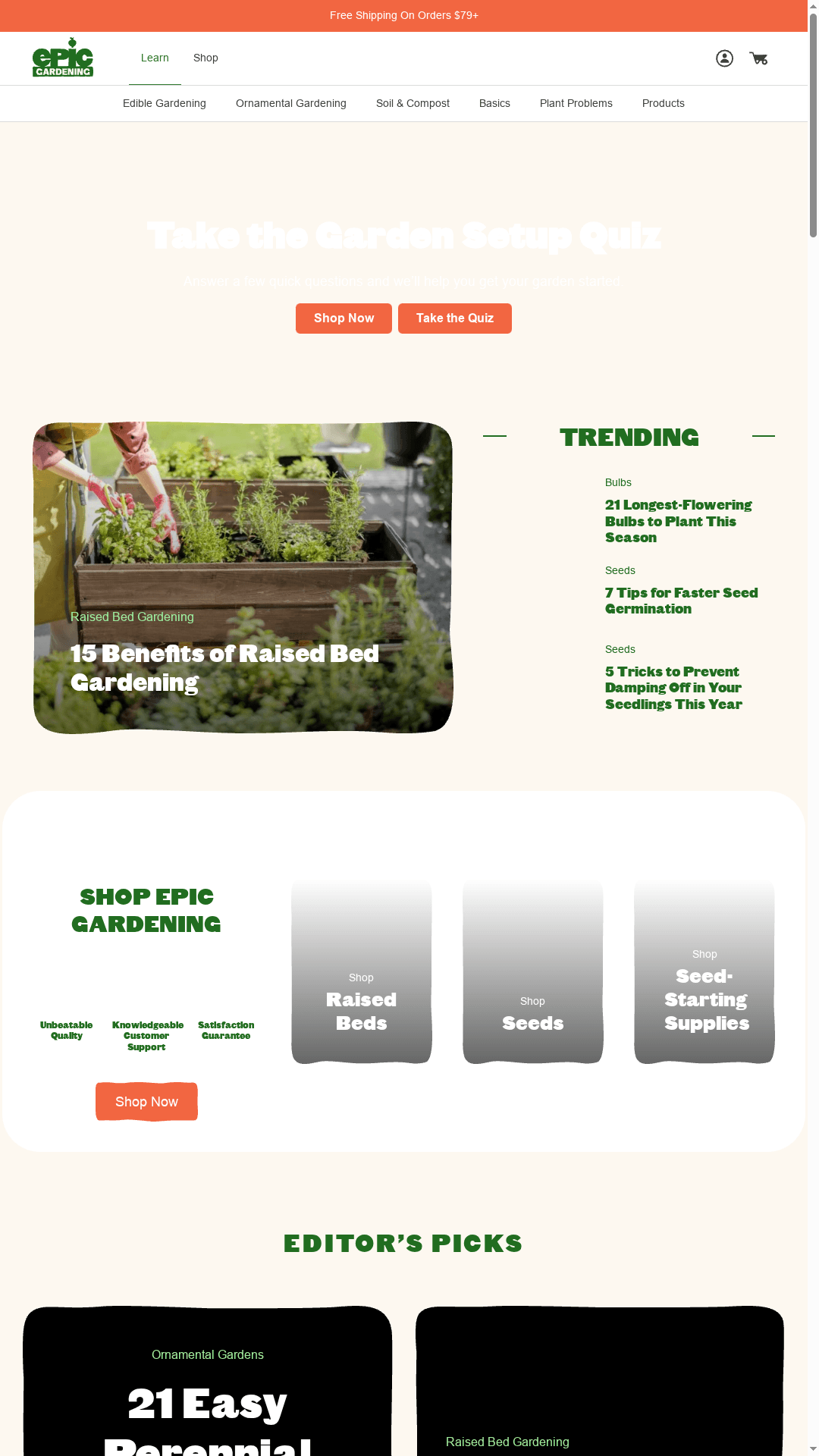
At a Glance
Epic Gardening combines practical how-to guidance with a broad product catalog, making it a one-stop resource for gardeners from first-timers to experienced growers. The site focuses on clear, actionable advice—seed starting, raised beds, and seasonal tips are central themes—paired with curated products like seed packets and garden kits. If you want straightforward instructions plus the tools to act, Epic Gardening delivers; if you need deep international climate coverage or detailed shipping policies, expect some gaps.
Core Features
Epic Gardening’s core strengths are its content library and product selection. The site provides practical gardening tips for both beginners and advanced gardeners, step-by-step guides on seed starting and plant care, and garden design inspiration. Complementing the editorial content is an extensive catalog that includes raised beds, seeds, seed-starting supplies, and tools, plus specialized kits such as the 3-minute raised bed and extension kit. Seasonal articles and niche-focused content round out the offering, making it easy to match guidance with the items you can buy.
Pros
- Comprehensive gardening resources and guides: The site offers a wide range of articles and how-to content that help users tackle common gardening projects from start to finish.
- Wide range of garden products and supplies: Epic Gardening lists seeds, raised beds, and tools so you can pair advice with the right gear in one place.
- Focus on beginner-friendly solutions and ease of assembly: Product kits and simple instructions are designed to lower the barrier for newcomers.
- Seasonal and niche-specific content available: Timely tips and specialized articles help you plan for seasons and specific garden types.
- Good customer support and satisfaction guarantee: The provided data highlights favorable support and a satisfaction emphasis that gives buyers extra confidence.
Cons
- Limited information on shipping policies and customer reviews in the provided content: The available summary does not include clear shipping details or a large body of customer feedback.
- Specific product pricing and availability may vary: Prices are not uniformly listed and can change depending on the item, which makes budgeting less predictable.
- Focus mainly on North American gardening conditions: Guidance and seasonal advice emphasize North American climates, which may limit relevance for gardeners in other regions.
Who It’s For
Epic Gardening is ideal for home gardeners of all levels who want clear, actionable advice and an easy route to purchase recommended supplies. Beginners will appreciate the step-by-step seed-starting guides and easy-assemble kits, while experienced gardeners can find specialized tools and inspiration for garden design and niche projects.
Unique Value Proposition
Epic Gardening’s value lies in combining practical, beginner-friendly education with an accessible product catalog—so you rarely have to hunt elsewhere for the supplies that match the advice. The inclusion of curated kits, seasonal content, and concise how-tos creates a direct learning-to-action pathway.
Real World Use Case
A novice gardener reads Epic Gardening’s seed-starting guide, buys a starter seed packet and a 3-minute raised bed kit from the catalog, follows seasonal maintenance tips, and successfully harvests their first vegetables—learning the whole process without jumping between multiple sources.
Pricing
Starting at $2.69 for select seed packets, with garden kits around $129.99; overall prices vary by product.
Website: https://epicgardening.com
Gardeners’ Path
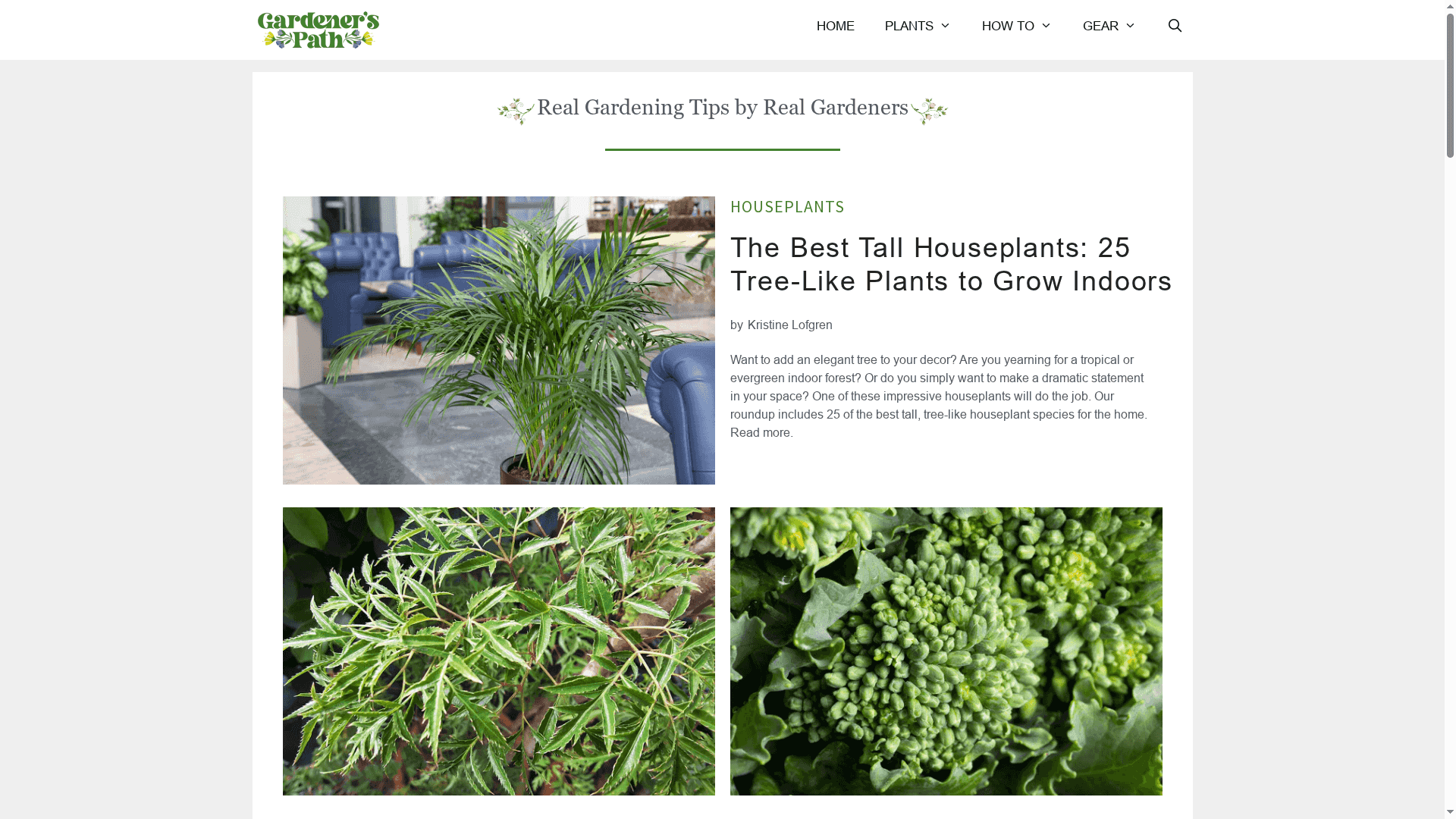
At a Glance
Gardeners’ Path is a broad, free online hub that aims to be the go-to source for practical horticulture advice, from inspiration to project completion. It serves both beginners and experienced gardeners with step-by-step plant care guides, recent how-tos, and expert contributions that boost credibility. The site’s wide coverage—houseplants, vegetables, flowers, shrubs, trees, and gear—makes it a reliable one-stop reference for everyday gardening questions. Bottom line: excellent for practical guidance and ideas, though specialists may need deeper, niche resources for advanced techniques.
Core Features
Gardeners’ Path delivers a steady stream of horticulture advice and gardening tips through plant care guides and how-to articles, supported by regular updates and expert contributions. The site covers a wide range of topics—houseplants, vegetables, flowers, shrubs, landscape trees—and also includes practical information on gardening tools and gear. Content is organized to guide you from inspiration through planning and hands-on execution, making complex projects feel manageable for home gardeners.
Pros
- Comprehensive resource: The site covers a wide array of gardening topics so you can find advice on everything from indoor plant care to landscape trees in one place.
- Expert contributions: Articles include input from knowledgeable writers and contributors, which increases trust in the recommendations provided.
- Practical guides for all levels: The how-to format and step-by-step guides make it straightforward for beginners while still offering useful angles for experienced gardeners.
- Regularly updated: New guides and tips are added frequently, keeping seasonal and trending topics fresh and relevant.
- User-friendly navigation: The site layout helps you quickly find the subject area or project you care about, saving time when you need an answer fast.
Cons
- Broad coverage limits depth: Because the site spans many topics, some specialized techniques are treated at a general level rather than in exhaustive detail.
- Website design could be modernized: The visual design and engagement elements feel functional but could be more contemporary to improve long browsing sessions.
- Advanced gardeners may need more: Certain guides assume foundational knowledge and may require you to consult additional, specialized sources for expert-level techniques.
Who It’s For
Gardeners’ Path is ideal for gardening enthusiasts of all skill levels—especially beginners and home gardeners who want clear, practical instructions. It’s also a strong fit for indoor plant keepers, vegetable gardeners, and homeowners planning landscape or garden projects who want reliable advice without paying for premium content.
Unique Value Proposition
Gardeners’ Path stands out as a free, well-rounded gardening education hub that blends practical how-tos with expert-backed insight. Its strength is the breadth of usable content and the steady cadence of new guides that help gardeners move from idea to finished project without hunting multiple sources.
Real World Use Case
A homeowner struggling with underperforming indoor trees can follow Gardeners’ Path step-by-step care guides to diagnose issues, adjust watering and light, and implement corrective pruning—resulting in healthier foliage and improved room aesthetics.
Pricing
Free access to all content
Website: https://gardenerspath.com
Smart Garden Guide
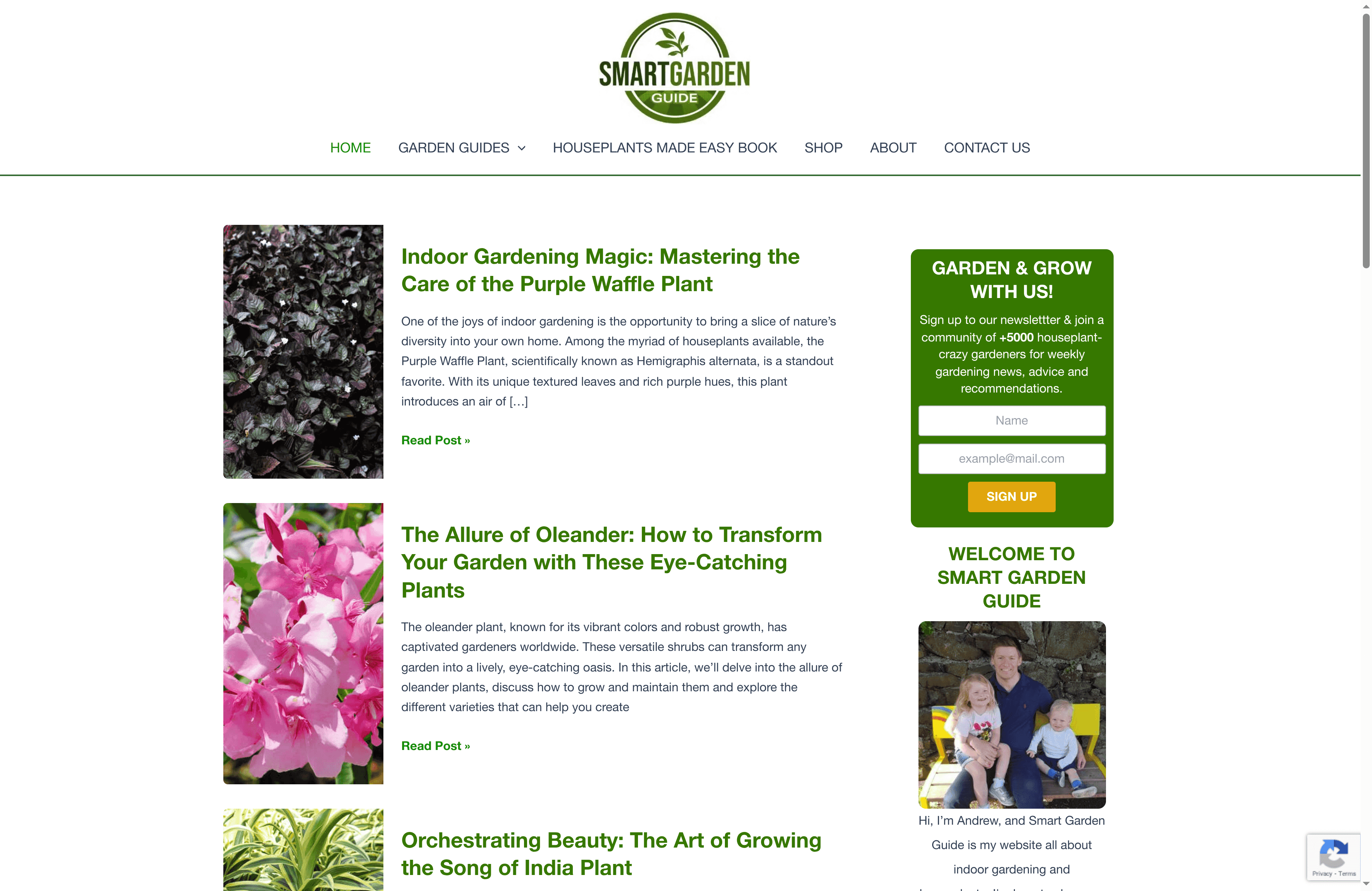
At a Glance
Smart Garden Guide is a free, text-forward resource that walks you through plant care for both indoor and select outdoor species with clarity and warmth. It’s especially useful if you want reliable, regularly updated how-tos for houseplants and specific garden varieties without paywalls. It doesn’t sell plants or hardware, so expect guidance rather than shopping. Practical, accessible, and well-organized for everyday gardeners.
Core Features
Smart Garden Guide centers on deep-dive articles and practical how-to guides covering a wide range of houseplants and garden plants. The site organizes plant variety descriptions with clear care and maintenance advice, step-by-step techniques for common gardening tasks, and targeted tips for indoor plant success. Content is laid out in a user-friendly format that works for beginners, yet contains detailed entries that experienced gardeners can reference for advanced care points.
Pros
- Comprehensive and accessible information: The site compiles a wide set of plant guides so you can find care instructions for many popular species in one place.
- Focused on indoor gardening: The emphasis on houseplants makes it especially valuable for apartment gardeners and indoor plant collectors.
- Detailed care and maintenance tips: Articles include practical steps that help you troubleshoot watering, light, and feeding issues for specific plants.
- Suitable for all experience levels: Content is written to be approachable for beginners while still offering enough detail to benefit experienced gardeners.
- Regularly updated content: Guides and plant profiles are refreshed, which helps keep recommendations current and trustworthy.
Cons
- Limited landscape and outdoor breadth: The site’s outdoor coverage is narrower and focuses more on individual plant profiles than broad landscape planning.
- No direct e-commerce or plant purchasing options: If you want to buy plants or gear from the same site, you won’t find an integrated shop here.
- Mainly textual content with limited multimedia: If you learn best from video demonstrations or interactive tools, the primarily written format can feel restrictive.
Who It’s For
Smart Garden Guide is ideal for home gardeners, indoor plant enthusiasts, and beginners learning the basics of houseplant care. It also serves landscape designers or experienced gardeners who need quick reference entries about specific species or maintenance techniques without wading through marketing copy.
Unique Value Proposition
What sets Smart Garden Guide apart is its commitment to practical, no-frills plant education that’s freely accessible. It prioritizes clarity and real-world advice over flashy features, making it a dependable reference when you need straightforward solutions for plant problems.
Real World Use Case
Imagine you’ve rescued a struggling marble queen pothos and want step-by-step recovery advice: Smart Garden Guide walks you through light adjustments, repotting choices, and watering cadence specific to that variety. Or you’re planning a garden update and want facts on oleander or moonglow juniper maintenance—find targeted care notes without searching multiple sites.
Pricing
Free access to all guides and articles
Website: https://smartgardenguide.com
Gardening Know How
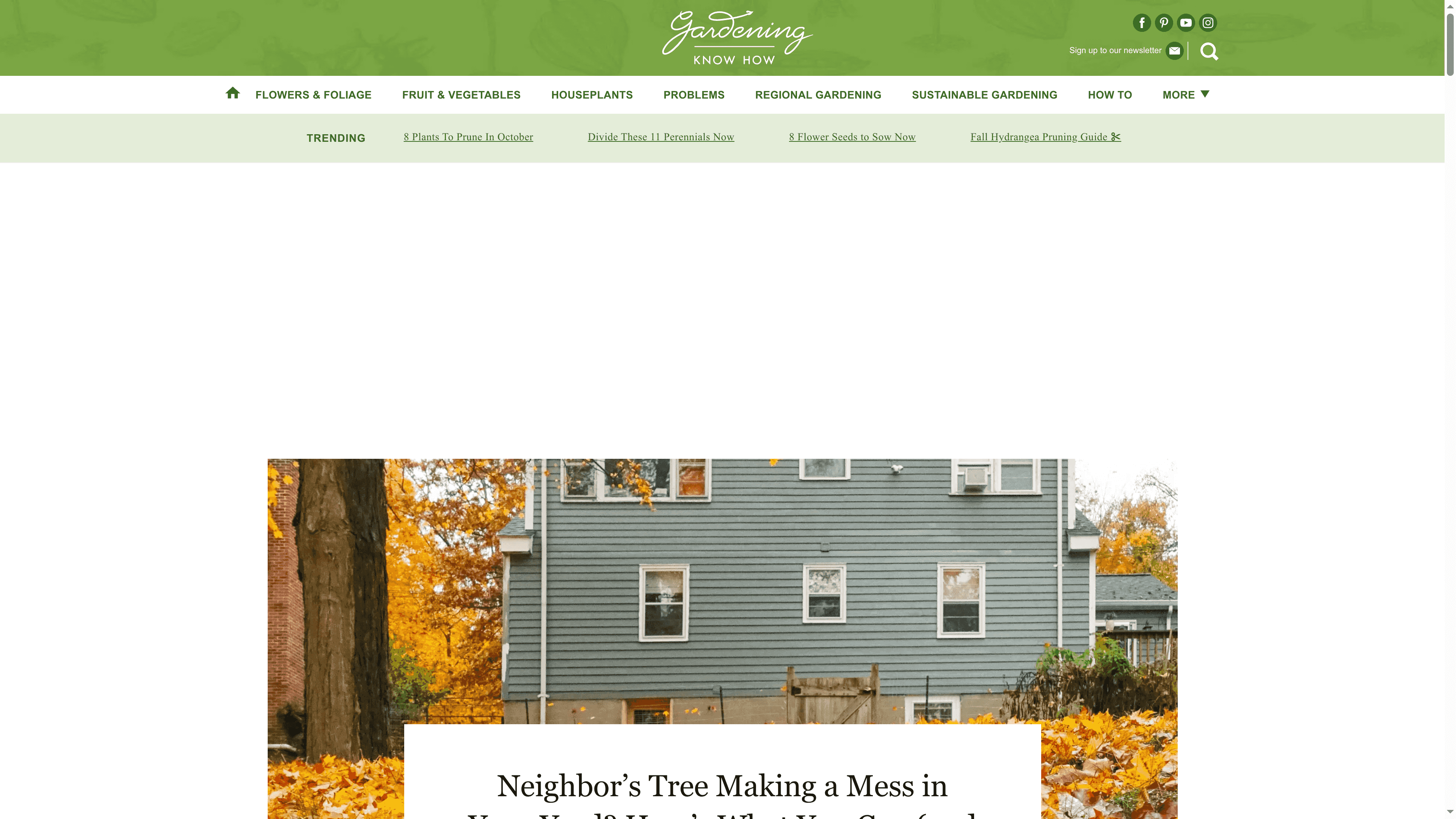
At a Glance
Gardening Know How is a deep, user-friendly resource for gardeners who want clear, practical guidance without the fluff. The site bundles expert-written articles, step-by-step guides, and learning resources that help both beginners and experienced growers get measurable results. If you prefer instruction and technique over storefront browsing, this is a go-to reference.
Core Features
Gardening Know How focuses on comprehensive gardening tips and guides, with expert advice and insights from gardening professionals. The site supports deeper learning through courses and workshops, and offers downloadable e-books on focused topics like tomato growing. It also emphasizes native plant information and wildlife-friendly gardening, helping you plan ecosystems as well as beds.
Pros
- Broad topic coverage: The site addresses a wide range of gardening subjects, so you can find guidance on everything from plant care to garden design in one place.
- Expert contributors: Articles and tutorials are informed by gardening professionals, which adds credibility and practical depth to the advice.
- Accessible for all skill levels: Content is useful for both beginners learning basics and experienced gardeners seeking refinements or new techniques.
- Practical, hands-on projects: The site includes DIY tips and projects you can try in a weekend, making theory immediately actionable.
- Structured learning options: Paid courses and workshops expand on free content, offering a clear pathway for skill development.
Cons
- Content is heavily informational with less product focus: If you came to shop for tools or lights, you’ll find articles rather than a curated product marketplace.
- No direct e-commerce or product listings: The site lacks integrated product pages or a storefront, so purchasing requires leaving the site or searching elsewhere.
- Advanced content needs engagement: Some deeper learning relies on active participation in courses or workshops, so passive readers might miss full benefit.
Who It’s For
Gardening Know How is ideal for gardeners of all levels who want practical advice and expert guidance rather than a retail experience. You’re a homeowner aiming to improve your garden’s health, a balcony grower learning plant care, or a vegetable gardener planning a productive season — this site suits you.
Unique Value Proposition
What sets Gardening Know How apart is its combination of breadth and instructional depth: free, searchable guides for immediate problems plus structured courses and e-books for systematic learning. It’s more like a coaching library than a product catalog.
Real World Use Case
A homeowner uses Gardening Know How to diagnose poor tomato growth, follows a step-by-step guide on nutrient management, and then enrolls in a short course to learn season-long care — resulting in noticeably healthier plants and higher yields.
Pricing
Free access to articles and guides; paid courses and e-books available.
Website: https://gardeningknowhow.com
Gardening Resources Comparison
This table compares popular gardening resources, highlighting their core features, pros, cons, pricing, and ideal user profiles.
| Platform | Core Features | Pros | Cons | Pricing |
|---|---|---|---|---|
| Lushy Gardens | Curated content, expert comparisons, indoor plant focus | Comprehensive guides, expert insights, community touch | No e-commerce or live features | Free |
| The Spruce | Rigorous product reviews, expert guides in gardening and home improvement | Trusted reviews, wide topic range, expert advice | No direct sales, overwhelming volume | Free |
| Gardenista | Design-focused content, subscriber newsletters, curated product lists | Design inspiration, seasonal updates, ad-free option | Paywall for archives, focus on outdoor design | $5/month – $9.99/month |
| Epic Gardening | How-to guidance, product catalog, seed starting, and seasonal tips | Comprehensive resources, beginner-friendly, good customer support | Limited global advice, variable pricing | Starting $2.69 for seeds |
| Gardeners’ Path | Practical guides, expert contributions, houseplants, vegetables, flowers, and gear | Comprehensive coverage, expert input, user-friendly | Broad coverage limits depth, outdated design | Free |
| Smart Garden Guide | In-depth plant care articles, step-by-step guides, indoor and select outdoor species | Comprehensive plant guides, detailed maintenance tips | Limited outdoor focus, no e-commerce | Free |
| Gardening Know How | Expert-written articles, learning resources, courses, and workshops | Expert guidance, practical projects, accessible for all levels | Informative vs product focus, no integrated shopping | Free (with paid courses) |
Find the Perfect Indoor Plant Light for Thriving Greens
Choosing the right indoor plant light can feel overwhelming when you want your favorite plants to flourish under your care. Whether you’re struggling with low sunlight or trying to create an ideal environment for your leafy friends, understanding terms like lumens, light spectrum, and energy efficiency is key to success. The right light can transform your indoor garden from struggling to stunning and boost your confidence as a plant lover.
At Lushy Gardens, we specialize in practical plant care tips to help you overcome these challenges without guesswork. Explore our Indoor Plants guides to learn how lighting impacts plant health. Dive into detailed Reviews where we compare the best grow lights and garden tools for indoor use. Ready to find your perfect light solution now Check out Garden Tools & Equipment for expert advice and product recommendations. Visit Lushy Gardens today and shine bright on your indoor gardening journey.
Frequently Asked Questions
What are the main types of indoor plant lights available?
Indoor plant lights typically fall into three main categories: fluorescent, LED, and incandescent. Evaluate your plant’s needs and select a type that matches light intensity and energy efficiency requirements. For example, LED lights can provide similar brightness while consuming up to 80% less energy than incandescent options.
How do I determine the right light intensity for my indoor plants?
To determine the right light intensity, consider your plants’ scientific light needs and measure the lumens output of your light source. Generally, low-light plants need about 50-100 foot-candles of light, while medium-light plants require around 100-200 foot-candles. Adjust your lighting setup based on how your plants respond, aiming for increased growth within 2-4 weeks.
What is the optimal duration for indoor plant lighting?
Most indoor plants thrive with approximately 12-16 hours of light daily, simulating their natural environment. Use a timer to automate your lighting schedule, ensuring consistency and reducing the risk of overexposure, which can harm your plants.
How can I position my indoor plant lights to maximize growth?
Position your lights 6-12 inches above the plants, adjusting based on the light type and the specific needs of each plant species. Monitor plant response closely, and adjust the height if you notice stretching or yellowing leaves, aiming for optimal placement within a week of setup.
Should I use a combination of different types of lights for my indoor garden?
Yes, using a combination of light types can provide a balanced spectrum that meets varied plant needs, promoting healthier growth. For example, you can supplement your primary LED lights with fluorescent lights for specific plants that thrive under different light conditions. Experiment with this mix to observe changes in growth patterns over the course of a few weeks.
How do I know if my indoor plant light is suitable for my plant species?
Research the specific light requirements of your plant species, including preferred intensity and duration. Compare this information against the specifications of your indoor plant light, ensuring it falls within the ideal ranges for growth. Adjust your lighting setup based on results observed after 4-6 weeks to optimize plant health.
Recommended
- 7 Types of Indoor Plants to Brighten Your Home – Lushy Gardens
- Can LED Lights Grow Plants? – Lushy Gardens
- Home – Lushy Gardens
I’m Eleanor, a seasoned gardener with over three decades of experience tending to Mother Nature’s creations. Through Lushy Gardens, I aim to share my wealth of knowledge and help fellow plant enthusiasts uncover the wonders of gardening. Let’s dive into this journey together, one leaf at a time.